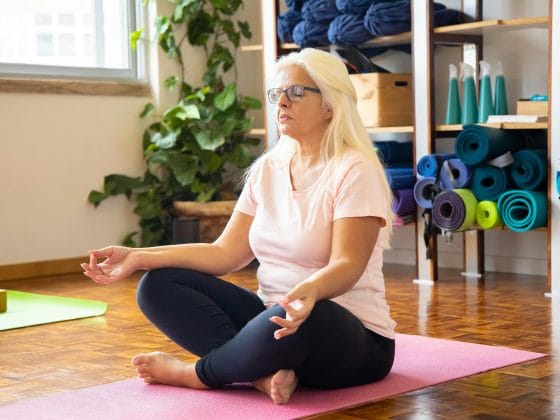So, you’ve heard of breathwork and now you’re wondering, “what’s all the hype about breathing? I do it every day.” Well, let me tell you, you’ve NEVER breathed like this. If you’re ready to jump into a new state of being – energetically, spiritually, physically, emotionally, and mentally – then keep reading.
Understanding Breathwork
This ancient practice taps into the power of conscious breath control to catalyse inner transformation. Over time, different forms of breathwork have emerged – each with its unique patterns.
Thanks to celebrities like Gwyneth Paltrow, Justin Bieber, and Beyoncé, breathwork has gained widespread recognition, while igniting a surge of public interest. If it’s good enough for Beyoncé, it’s good enough for us!
The science behind breathwork is fascinating. Our breath has a direct impact on our nervous system, including the sympathetic and parasympathetic systems. When we perceive danger, the sympathetic nervous system (SNS) kicks in, increasing our breath rate and opening our airways to allow for greater oxygen intake, which heightens our alertness.
Once the danger subsides, the parasympathetic nervous system (PNS) restores our body to its normal state and breathing pattern. So, essentially, breathing either makes us stressed AF or chilled AF, depending on what we’re experiencing in our immediate environments.

The Different Types of Breathwork
Breathwork is a means through which you can deeply connect to your mind, body, and spirit. Implementing daily breathing practices has proved to be invaluable in helping me to calm my mind, reduce my stress, improve bodily discomfort, and get radiant skin. Who knew that breathing could be better than a facial! Let’s dive into the different techniques:
1. Diaphragmic Breathing
Diaphragmatic breathing, also known as belly or abdominal breathing, involves using the muscles to stimulate the diaphragm, allowing increased air intake into the lungs. This technique improves concentration and reduces adverse emotions.
This is actually our most natural state of breathing. Just look at the belly of a young child or an animal. They naturally breathe through their bellies, while we adults breathe through our chest muscles. If you’re feeling stressed, focus on breathing through your belly and feel how the stress melts away!
2. Box breathing
Also known as square or four-square breathing, is a relaxation technique where we inhale, hold the breath, exhale, and then hold it again for equal counts. This cycle is repeated to reduce stress, enhance focus, and promote relaxation.
I have found this to be particularly useful in reducing anxiety or calming my mind before I get into bed. Box breathing is a key component that helps me have a good night’s rest.
3. Circular breathing
Another one of my favourites. it helps release unwanted emotions, clear stagnant energy, and provide deep spiritual insights. It involves visualisation techniques, where you imagine your body being filled with pure energy as you inhale, while any bad energy leaves your body with an exhale.
You can also visualize roots growing from your feet and legs, grounding you into the earth. I practice this visualisation technique while in nature, which really helps to calm and ground me. This technique takes some getting used to, but once you get it, you’ll always refer back to it!

4. Rebirthing Breathwork/ Conscious Energy Breathing
So, personally, I haven’t done this one, but it sounds interesting! This is a version of circular breathing that lasts for 2-3 hours per session and should be done with a trained facilitator. It is used to do deep emotional and inner child work.
This is an intense experience where you come face to face with many unhealed traumas and wounds. If you opt for this option, have some tissues at hand.
5. Shamanic Breathwork
Shamanic breathwork can lead to altered states of consciousness, and sessions usually last one to two hours, since it combines multiple sensory experiences. It is often combined with music, movement, smudging, chanting, and setting intentions before practitioners breathe in rhythm to primal music, such as the sound of drums.
Chakra healing and spirit animal contact may also be incorporated. This is definitely something to do with a trained Shaman, who has the knowledge to guide you through altered states.
6. The 4-7-8 Relaxing Breath
This technique involves inhaling for 4 seconds, holding the breath for 7 seconds, and exhaling for 8 seconds.
I do this almost every day because it is so simple and effective. Its purpose is to induce relaxation and is frequently used for stress reduction. I typically do about 10 rounds, after which I feel calm and clear-minded.
7. Wim Hof Method
If you’ve ever searched for information or videos about breathwork, you’ve likely come across the infamous Wim Hof. He focuses on a series of deep breaths, breath retention, controlled exhales, and cold exposure to radically improve the immune system.
My dad used to get sick A LOT, and since incorporating this method into his daily practice for the past 3 years, he never gets sick. There is quite a lot of scientific research to back-up Wim’s claims. So, do yourself a favour and check him out!

8. Pranayama breathwork
This is the most ancient Yogic breathwork that you’ll come across in yoga practices or yoga teacher training.
There are all sorts of techniques that fall under this category, including Alternate Nostril Breathing, Skull Shining Breath, and Ujjayi. I love pranayama and as a yoga teacher, I incorporate at least one of these methods on a daily basis.
9. SOMA Breathwork
This builds on pranayama, but adds specific brainwave music to help generate new neural pathways.
It’s main objective is to teach people to breathe through their noses. If you didn’t know this, we’re not meant to breathe through our mouths. It causes inflammation in our airways and can create some nasty infections.

10. Neurodynamic Breathwork
This is an interesting one. Apparently, if you do this breathing technique, you’ll be connected to your higher self. It allows you to step out of your busy mind and into a more aware state of consciousness.
This is especially beneficial for those who work with emotional blockages or healing modalities, in order to gain a deeper connection with their profound inner wisdom and intuition. I’m definitely trying this tonight!
11. Somatic Breath Therapy
If you haven’t heard of somatic therapy, you really need to get on this train. It helps you to reconnect to your body’s wisdom, while helping you to release stored emotions and trauma from your body.
This has single-handedly been the foundation of my healing journey with anxiety and depression. This is a deeply relaxing and gentle technique that is ideal when you’re ready to wind down and release some built up emotions that just doesn’t seem to want to come out.
12. Transformational Breathwork
Another one of my favourites. Be sure to do this one with a friend or trained facilitator, since you will be releasing A LOT of stored emotions.
Expect some crying, laughing, and screaming all at the same time. Fun! The focus here is on teaching yourself how to release what no longer serves you. Transformational is definitely an accurate description.

Incorporating Breathwork into Your Daily Life
I allocate dedicated time each day to practice my favourite techniques. In the beginning, I started off slow – gradually increasing the duration and intensity of my practice, which allowed my body and mind to adapt to this new habit.
With consistency, I began to experience the profound benefits of breathwork— and in my case, it was most powerful with regards to releasing blocked emotions. I also try my best to incorporate mindful breathing techniques throughout my day (which is actually much easier than you might think).
During moments of stress or anxiety, I take a few deep breaths to calm my mind and redirect my energy. Breathwork really doesn’t have to be complicated. You’re breathing right now. The only difference with breathwork is that you’re adding an intention, a pattern, and some conscious awareness. If you want to go deeper into these practices, there are a ton of courses out there.
In summary
If you’ve been looking for a powerful and easy tool that allows you to increase your mental clarity, overall energy, while removing unwanted and outdated emotions – breathwork is your new best friend. Do some research and experiment with the different techniques.
You’ll find your favourites. Then, stick to it for at least a month in order to make it a habit. If you want to say goodbye to anxiety, depression, and feelings of sadness, anger, and despair – you have to give this a try. It’s life-changing!



